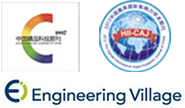Abstract:
Considering radial delamination of fiber winding composite flywheel at high speed, an annular plain woven fabric with both circumferential and radial reinforcement was proposed, and the prominent feature of new texture was that the circular yarn was continuously woven by a single fiber bundle. The representative volume unit cell with "flat spindle" section was established to deal with the differences between bidirectional yarn profiles. By means of structural similarity between sectorial and rectangular unit cell, constraint conditions for isoparametric weaving were defined. The volume averaging method was used to predict effective elastic parameters for sectorial unit cell of ring fabric. Based on the idea of multi-layered segmentation of rims, the stress and deformation characteristics of woven flywheel under rotating load and correlative influencing parameters were analyzed. The theoretical displacement shows good agreement with radial deformation measurement results using circles marking method. The maximum tangential speed of woven flywheel achieves 889 m/s, and the corresponding energy density reaches 63.7 Wh/kg. Both theoretical analysis and experimental results prove that the bidirectional reinforcement theory of circular texture is practicable. And woven composite flywheel is well promising in technological process to achieve higher rotation speed than traditional winding ones.


 下载:
下载: